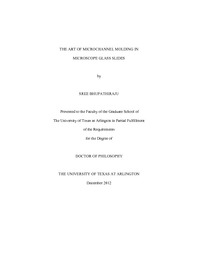| dc.description.abstract | This research is an effort to develop a new process by combining engineering principles with the history of glass art molding to develop clear micro-level test features in glass, for bio-medical and drug experiments dealing with cells, tissue, and micro-level organisms. Most of the present research in the bio-medical field involving micro-level cell and brain tissue testing is done using expensive glass or developed using Polydimethylsiloxane (PDMS) as the main material. Disadvantages of PDMS is that, over time the cell or blood tissue reacts with polymers causing a reduction in clarity making it difficult for a research scientist to observe the growth and reactions of the cells and tissue. Glass can be used to overcome many troublesome issues of PDMS due to such properties as: 1) high chemical resistance, 2) good light transmission which allows direct visualization of chemical or cell reactions, 3) high thermal and electrical resistance which allows the application of high voltage for electrophoretic separation and 4) good mechanical stability allowing application of high hydraulic pressure for transporting fluids inside micro-channels. Research into existing inexpensive low-quality glass, has resulted glass slides which can be used by bio-researchers for many applications. Soda-lime glass slides have been in use by biomedical researchers to conduct experiments for decades. The only constraint was they were used as raw glass slides, without any additional manufacturing being done on the slides due to their machinability restrictions. Fabricating micro features in glass is a challenging task as glass reacts differently to different die materials, micro feature manufacturing processes, and different process temperatures. These issues have kept researchers from using inexpensive low-quality sodalime glass, such as that used for the manufacture of microscope slides.The aim of this research is to understand the principles and reactions of glass to varying temperature and machining processes, choosing a best machining process and material, optimizing the temperature and machining variations of glass with the selected die material. The research objective was to produce clear micro-level features in glass. Standard glass microscope slides made of soda-lime glass were selected as the material of choice. The results of the study found mold materials, mold machining processes, glass working techniques, and optimal heat cycle for clear glass working of microfeatures. | |

